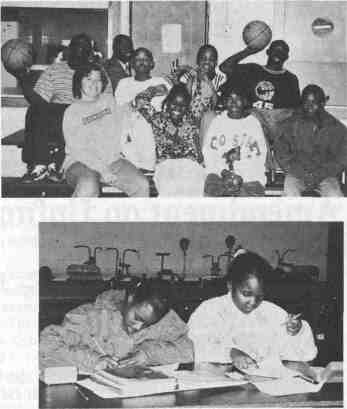INERGOVERNMENTAL COOPERATION
Between the Hours of 3 and 6 by Heather Young Gangs. Drugs. Theft. Violence. These are terms that we come into contact with each day. They make the headlines in our newspapers and the lead story on the evening news. More disturbing is the fact that these acts are being committed not only by hardened criminals, but by our children. Most prevalently, by our teenagers...our future. According to the September 18, 1995, Chicago Tribune, the National Center for Juvenile Justice released a study on juvenile crime that found more kids are committing violent offenses and more are likely to do so in the future. From 1983 to 1992, the rate at which juveniles ages 10 to 17 were arrested for violent offenses doubled, and this rate is expected to double again by 2010. One of the most revealing findings in this report is that prime time for juvenile violence isn't after dark. It happens between 3 p.m. and 6 p.m., the hours after school. This suggests a need for after-school programming aimed at youth who are in the 10 to 17 age group; kids who are considered at-risk youth. The Urbana Park District is in its second year of an at-risk youth program entitled the Lakeside Terrace After School Program. Developed in cooperation with the Urbana School District and the Champaign County Housing Authority, the program serves youth in fifth through eighth grades or those ages 10 to 14 who live in the Lakeside Terrace housing complex in Urbana. The school district provides, free of charge, a grade school facility which serves as the program site and is located one block from the housing complex. The housing authority provides the funds necessary to run the program, and the park district takes care of overall planning and supervision of the program. The goals of the program are: • to provide opportunities for tutorial services and educational support; • to provide opportunities for preventive drug abuse education; • to provide opportunities for self-esteem and teamwork skill development through recreational activities; • to promote the development of skills in the areas of outdoor recreation, arts, crafts, dance, music, creative expression and physical education; and • to develop meaningful relationships with peers, teach and leaders. The program meets for two hours, twice a week through out the school year. The first hour is dedicated to educational support and tutoring. Participants are encouraged to bring their homework, and if they have none, then the hour is spent quietly reading a book or engaged in other passive activities. Drug and gang prevention are also incorporated into this part of program. Students who attend the tutorial portion of the program eligible to take part in organized recreation activities, arts and crafts projects, snack-time and field trips at no cost to the participant or parent. Activities may include nature walks, a karate demonstration and outdoor living skills. Field trips take kids to Fighting Illini football practices, bowling and trips to the zoo. Some kids spend the entire program studying. Others only tolerate the study hour in hopes that the day's recreation hour includes a good game of basketball. The program's primary method of recruiting is word-of-mouth. Of the forty middle-school-age kids at Lakeside Terrace, at least 25 have attended the program at one time or 8 ¦ Illinois Parks & Recreation ¦ January/February 1996 other; some on a regular basis, others not. An average of 15 kids attend the program each week. The Housing Authority maintains an office in the apartment complex. They stay in tune with the neighborhood and recommend the program to kids who might benefit from it. Behavior management is often a challenge, and a policy has been enacted for this reason. Program manager Teri McCarthy says, "Kids are not perfect. Add to that the uncertainties of these kid's home life. Many watch illegal activities take place in their living rooms. Others have abusive parents. Gangs recruit while promising protection, acceptance and friendship. Any or all of these challenges are bound to affect behavior." Of course, kids do act up. Fortunately, behavior problems among program participants have decreased significantly since last year. Most incidents are handled quickly using time-outs and several chances are given before the youth is asked to leave the program. The kids participate voluntarily; they like the program and realize that good behavior is required. The Lakeside Terrace After School Program is off to a good start. At-risk programming is a new area for park districts and will take some time to perfect. We are always looking for ways to improve and expand. Does the Urbana Park District feel like it is accomplishing anything? Absolutely. "We measure success in this particular program by the fact that the kids keep coming back," says superintendent of recreation Dan Gibble. "While they are there, they use their time productively to accomplish educational goals." Heather Young is the marketing and public information coordinator for the Urbana Park District. Top: Participants in the Lakeside Terrace After School Program pause their basketball game to pose with program volunteer Deb DiPietro. Bottom: Homework comes first in this supervised after-school setting.
Illinois Parks & Recreation • January/February 1996 • 9 |
||||||||||||||

